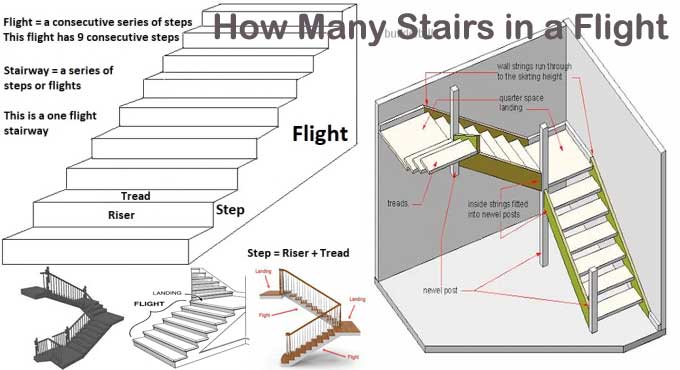
Types & Benefits of Flight of Stairs
There are a total of two floors or two landings in a flight of stairs. Stairwells are also known as flights of stairs. The question of stairs versus steps is often asked, but there are differences between the two. As the foot moves up and down the stairs, a step provides support.
A flight of stairs has no definite number of steps, but you can determine which type of staircase was used for a specific building and how many steps it required. The step number per floor cannot be determined without a definite answer.
You must have at least one change of direction for every flight of stairs that has more than 30 risers in a row, with a landing of equal length to the stairs' width if you intend to make it a dwelling.
If it's something other than a dwelling, there are two options. Firstly, if the number of risers between landings is 16, the stair is a utility stair. A general access stair is one with the number 12.
Types of Stairs
There are five types are detailed below, There are:
I. Straight Staircase
II. Half turn Staircase
III. Quarter turn Staircase
IV. Spiral Staircase
V. Helical Staircase
1. Straight Staircase
Straight staircases consist of one straight flight of stairs or, in some cases, two flights of stairs joined by a landing halfway up. Generally speaking, it's an economical solution.
However, it also consumes more space. A landing connects two staircases, providing a place for someone to rest in the middle. All treads on the stairs are rectangular and share the same dimensions, except for the landing between two flights.
2. Half turn Staircase
Half-turn staircases are variations of quarter-turn stairs. Half-turn stairs have two straight flights followed by two 90-degree turns. From bottom to top, the steps of this staircase curve 180 degrees. It occupies comparatively less room in the building.
Quarter turns may feature angle treads or intermediate landings, while the middle of the staircase may be an open space with several possible configurations depending on the layout. By reducing the tapering of the angled treads, you can also notice that there are times when this staircase takes turns, making the step more comfortable and safer.
3. Quarter turn Staircase
Quarter-turn staircases are two straight steps connected with a 90-degree quarter-turn. 90 degrees is the angle at which the steps turn.
Besides saving a lot of space in the building in which it's constructed, this stairwell is also known for being a very sturdy one. As we make our dream home with the trend to make it smart, these kinds of space-saving stairs will surely help us achieve it.
An intermediate landing between the steps or angled steps may be part of the stairway turn. You can turn anywhere on the staircase, at the bottom, middle, or top. Ascending and descending the staircase is more comfortable if the turn is also curved.
4. Spiral Staircase
An open stairwell spiral staircase has treads laid out on circular or polygonal plans, going around a circular or polygonal pillar or shaft.
The diameter is usually less than 150 centimeters, especially when used in an industrial setting. Generally, spiral staircase treads are narrower than all other types of stairs in small spaces. Additionally, it has some disadvantages, such as not helping furniture move due to its narrow width. Furthermore, it?s pronounced tapering increases the risk of the treads failing.
5. Helical Staircase
A helical staircase is a staircase where treads rotate in a circular, elliptical, or polygonal manner from their base. Helicopter staircases do not have treads installed around the pillar. Helical staircases are visually appealing. To design a helical staircase, you need special expertise. When it comes to the design of this stairway, it normally needs to be customized.
Benefits of Flights of Stairs
- Although landings may be required for longer staircases due to space constraints, they are more likely to only appear in structures with more rooms.
- If you live in a smaller home, a straight run or flight of stairs might not be possible.
- You might have to use a landing, and if you do, you will have two stairways instead of one.
- If you have well-finished hardwood treads and floating stairs, your staircase will be a centerpiece of your house.
- An impressive set of stairs can be born from flawless aesthetics and extraordinary finish details.
- It is not aesthetically different to break up a flight of stairs with a landing.
- Only one flight of stairs can save an area in a home along with appealing visualization.
- There are usually between 8 and 10 feet of ceilings in most houses, but 8 feet is the most common.
- There will nearly always be a flight of stairs if the ceiling height of the dwelling matches these levels unless the building is split-level.
- Stairways are more popular because a typical house lacks a landing, and it isn't a requirement.
Conclusion
It has become possible to make staircases look better and add aesthetics by creating nice curves and other features using steel and reinforced concrete.
Escalators and ladders are the two stair types. As an alternative to stairs, there are also other options. Elevators, stair-lifts, inclined walking walkways, and ramps belong to this category.
Public and private buildings have different building height regulations that affect how many steps a staircase has. A flight of stairs usually has 12 or 13 steps, but that also depends on the staircase's height and location. The construction of fire escape stairs is subject to more specific regulations.


